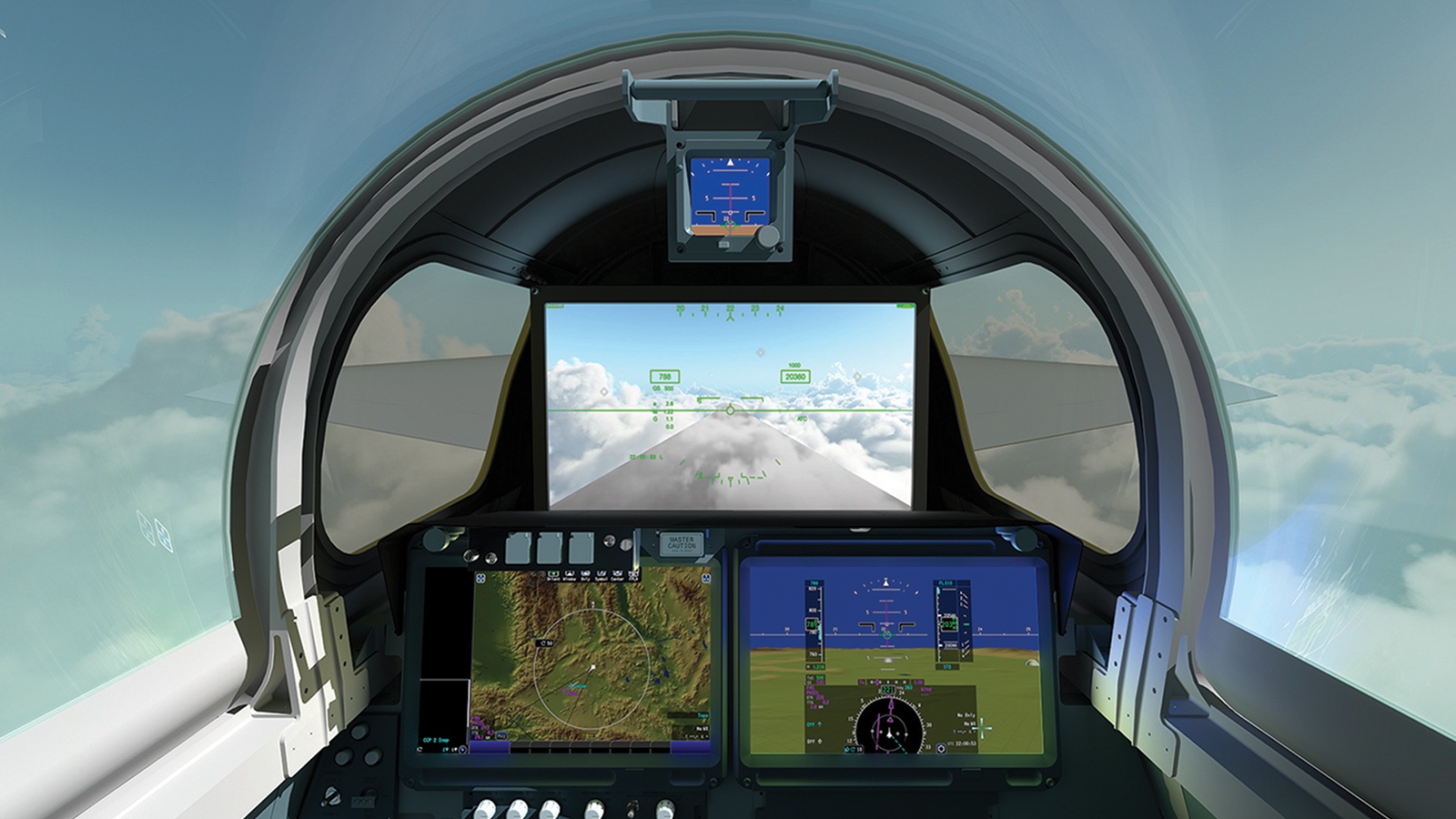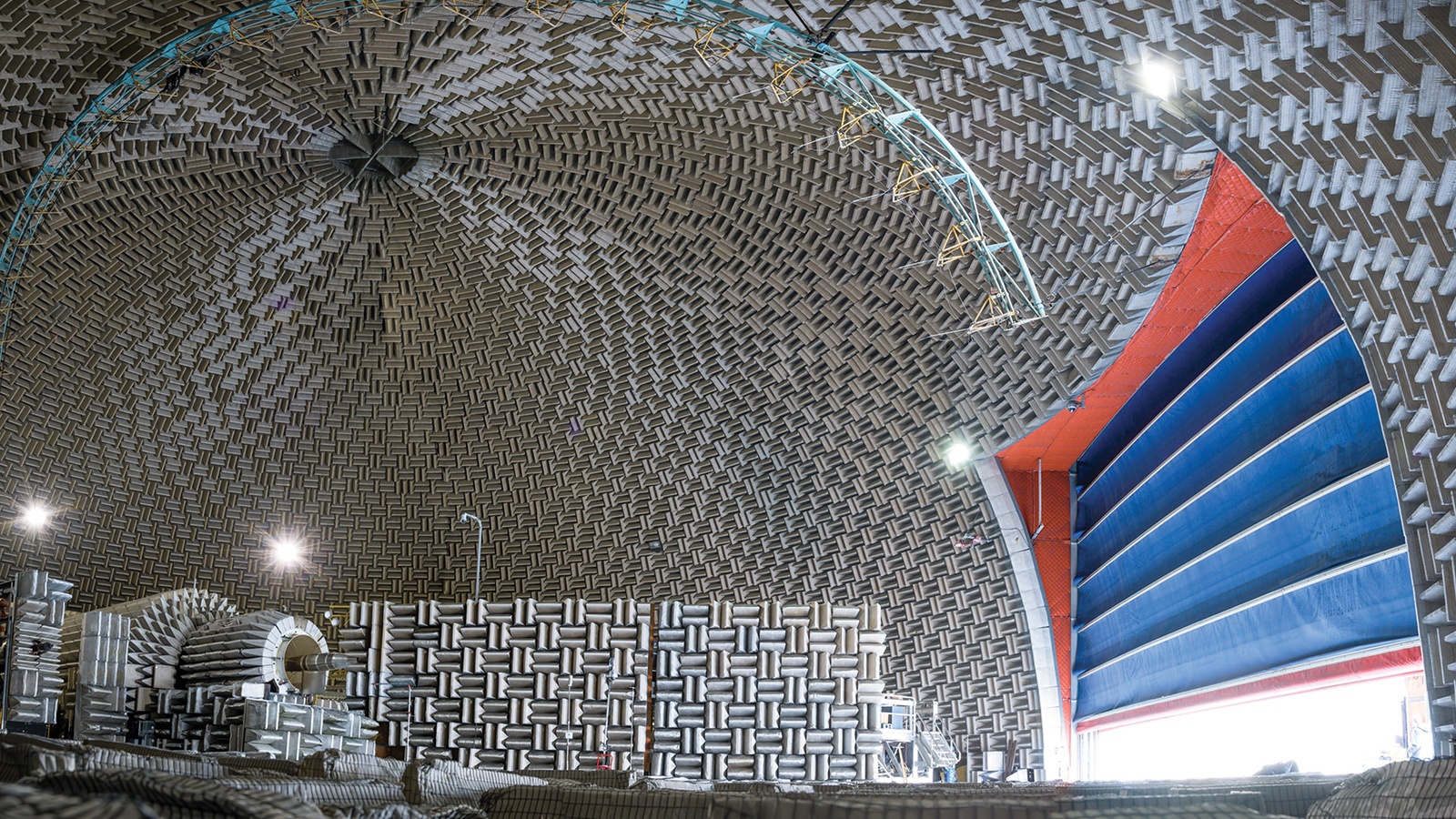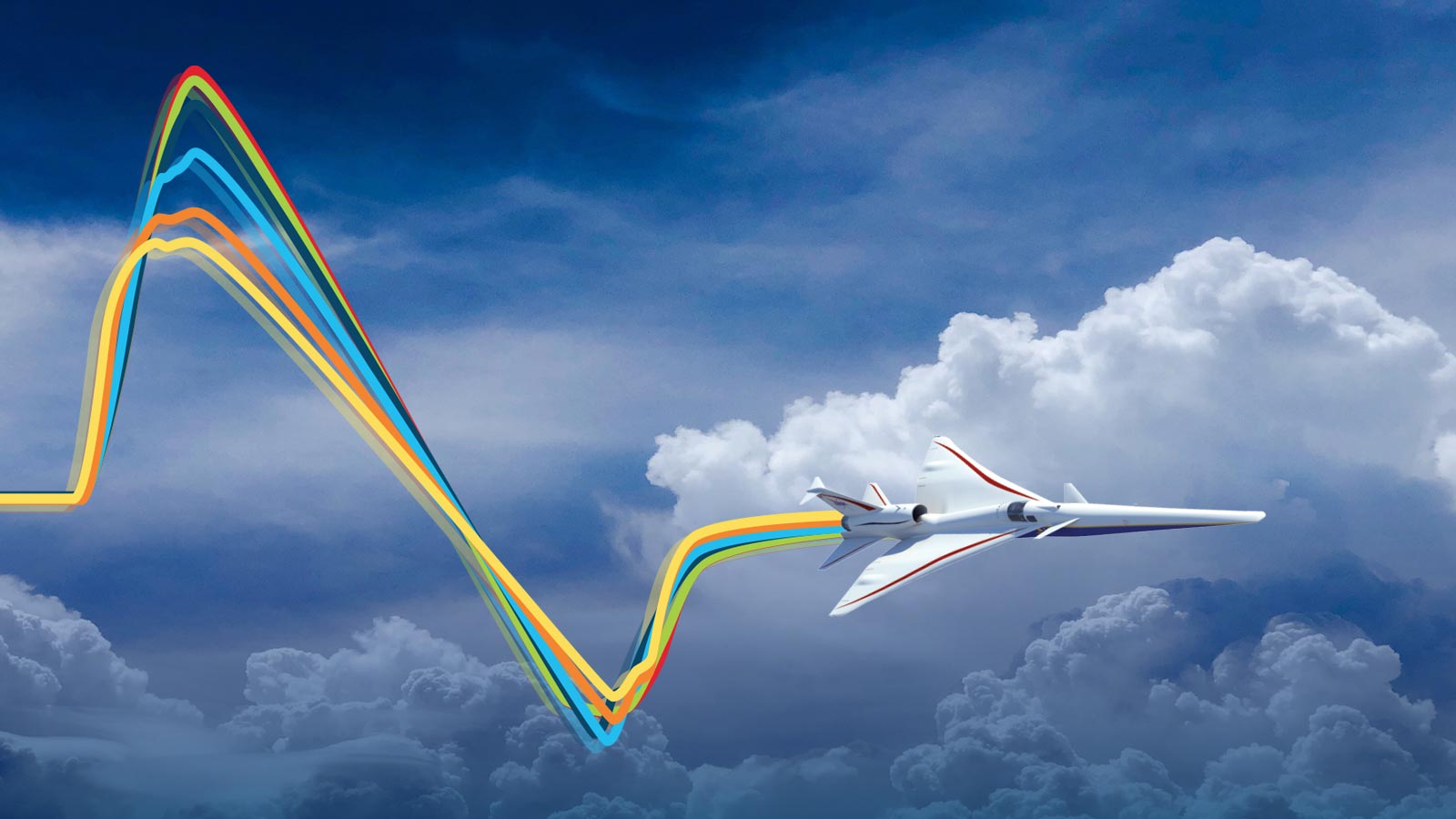Stay Up to Date
Submit your email address to receive the latest industry and Aerospace America news.
NASA’s Low Boom Flight Demonstration Program could help pave the way for supersonic air travel, provided U.S. populations and ultimately those abroad agree that the X-59’s thump instead of a boom is quiet enough.
If you live in the United States, you may be among the first people in the world to hear a “sonic thump,” that being the only audible indication that NASA’s X-59 Quiet Supersonic Technology jet is passing 55,000 feet overhead. NASA doesn’t highlight the following about QueSST, but the plane could even define the conditions that will produce no perceptible sound at all.
Also known as the Low Boom Flight Demonstrator, the piloted X-59, now in construction at Lockheed Martin Skunk Works in Palmdale, California, will cruise at 1,500 kph over a variety of locations around the United States from 2023 to 2025 to test the reaction of people to the sound. This community response study will include day and night flights over a variety of geographic and cultural settings ranging from urban to rural. The goal is to give FAA and international aviation regulators the survey data they will need to craft a global standard for en-route supersonic aircraft noise. In the U.S., this standard would end the ban on supersonic civilian flights over land that has been in place since March 1973, a factor that contributed to making the trans-ocean Concorde supersonic flights from 1976 to 2003 untenable in the long term.
The issue now is whether NASA can prove that a thump from a passing jet will be acceptable to the public in the U.S., and possibly abroad. This achievement would go a long way toward clearing the way for supersonic passenger travel, although cruise noise is far from the only factor in the environmental-acceptance equation that could still prevent commercial supersonic passenger travel from ever taking off. Others are working to resolve questions about damage to the stratosphere, plus the subsonic noise of takeoffs, departures, approaches and landing.
Sweet spot
Supersonic aircraft are in the works today, but not the kind NASA hopes to open the door to. The U.S.-based companies Aerion Supersonic, Boom and Spike want to reel in well-heeled business travelers mainly by flying over oceans. NASA has in mind overland flights and a much broader vision for supersonic flight.
“Our goal is to make it available for the average person eventually, not just the business jet” traveler, says NASA’s Dave Richwine of Langley Research Center in Virginia.
As the deputy project manager in charge of technology for the X-59 Low Boom Flight Demonstrator, his job is to make sure the technical work unfolds in a fully integrated manner from the current construction phase to acoustic validation flights in Phase 2 through the community response study in Phase 3.
A milestone will come next May, if all goes well, when the X-59’s forebody, its wing assembly and tail section or empennage are joined. “It starts to look like an airplane,” Richwine says.
Today’s supersonic pioneers have a basic sense of what’s needed for regularly scheduled passenger flight. Cruising at Mach 1.6 to potentially as high as Mach 1.8 (1,963 kph to 2,205 kph) will be “the sweet spot for supersonic air travel,” says David Richardson, director of air vehicle design and technologies at Skunk Works. At that speed, supersonic airliners could roughly halve the flight time needed to travel between New York and Los Angeles or Seattle and Miami.
The spot would be sweet for another reason, too, adds Richwine. Above Mach 1.6, “you start to get heating in your inlet and your engine, and all your control surface edges, and places where you have to do some heat mitigation measures that start to have a weight penalty,” he explains.
The X-59 won’t quite reach the sweet spot for a simple reason. It doesn’t need to. Some of the low-boom innovations, if not the basic X-59 design, might someday be adopted by commercial designers, but that is not the main mission. The top goal is to nail down the acceptable level and kind of noise for someone in a backyard or at a playground or on a hike, or “going about their daily lives,” as Richwine’s boss, Peter Coen, the low-boom mission manager, puts it.
Key is that the theorized thump reach the ground. That only requires flying at Mach 1.4, Richwine says. “It wouldn’t sound any different than it would at 1.6,” he explains. “We don’t have to have a lot of bypass and bleed, and all these other things that would drive the cost of the airplane up.”
Not overbuilding the plane is one strategy NASA is employing to control the cost of the $582 million effort.
NASA plans to collect dose-response data from average people and deliver that to the FAA’s Office of Environment and Energy and to the International Civil Aviation Organization’s Working Group 1, a panel of interested parties including Coen and representatives from U.S. and international aircraft companies.
Going worldwide
This initiative is presently the only effort to assess public acceptance of a low-boom supersonic aircraft. A consortium of European aviation manufacturers, academia and scientific research groups known as the Regulation and Norm for Low Sonic Boom Levels, or Rumble, aims to study human response to simulated sonic booms. The group has no plan to fly a low-boom research aircraft over Europe where overland supersonic flight is also banned and where environmental policies are increasingly strict.
Could international differences of opinion on the noise of supersonic aircraft lead to separate regulations instead of a global standard for cruise noise?
“There is always a possibility that U.S. standards could differ from standards eventually adopted by ICAO, but that is not a desired outcome,” the FAA replied. Responding to the same question, ICAO said only that “should such an analysis be conducted then the data would be considered by ICAO.”
Coen says NASA understands that any future standard for supersonic overland flight noise “will need to be an internationally agreed to standard.”
That’s why NASA is reaching out to engage international regulators and researchers in the planning process for the X-59 flights “so that the test and survey plans are as internationally applicable as possible.” He also says NASA is open to “discussion of using the X-59 for community response testing in locations outside the U.S.”
If NASA were to formally make such an offer, ICAO says it would give the idea “due consideration.”
Such flights could help speed the process of rulemaking for supersonic aircraft — a category the U.S. is keen to promote.
The U.S. Department of Transportation’s emphasis on innovation includes the FAA “taking steps to advance the development of supersonic aircraft,” according to the FAA’s “Supersonic Flight” fact sheet. The document also notes that the FAA Reauthorization Act of 2018 encourages the FAA administrator to “exercise leadership” in creating federal and international regulations and standards for certification and operation of civil supersonic aircraft.
Stretch goal
NASA says the X-59’s first flight is scheduled for some time in 2021. Phase 1 includes an approximately nine-month Flight Clearance stage to clear the way for acoustic validation and the community response phases, Coen says.
In the Phase 2 acoustic flights, a pilot will fly the X-59 at supersonic speeds over microphones arrayed across the desert floor of the range surrounding Edwards Air Force Base, California. “The purpose is to validate that the acoustic signature performance — how loud the airplane is as heard from the ground — matches our predictions for the full range of flight conditions that we expect to use in the community testing,” Coen explains.
The X-59 is designed to register 75 perceived level decibels, a unit of measure that takes into account the judgment of an average listener, according to Dictionary.com. Because the decibel scale grows louder logarithmically, this would be a significant improvement over the 100-plus decibel sonic booms typical of jet fighters and the Concordes.
NASA might even be able to do better than 75 PLDB.
“We’d like to get data down as low as 70, and we can do that a couple different ways through certain flight test maneuvers,” Richwine says. “We’re pretty convinced that there’s no one on this planet that could hear 70.”
Coen says that these bold goals are critical: “If we weren’t doing extraordinarily better than a sonic boom there would be no reason to build an airplane and conduct these community tests.”
Mapping the boom carpet
If Phase 2 goes as hoped, NASA will capture the sound over the entire boom carpet, meaning the swath of ground that’s exposed to the aircraft’s predicted sonic thump.
The microphone array on the desert floor will measure the sound at the ground level, and a NASA F-15 will probe the pressure waves that build up around airplanes in supersonic flight. Richwine explains that NASA wants to chronicle the waves that form under specific atmospheric conditions all the way from the region near the aircraft to below 15,000 feet. Of particular concern is wind turbulence below 10,000 feet, which can either soften a wave or make it louder. “We’re thinking that a rounded sonic boom wave, much like ours, which is more like a sine wave, would not suffer that kind of amplification or dampening. It would be less impacted by turbulence, which is a good thing.”
As an airplane accelerates past Mach 1, waves created by the nose collapse into a single shock wave, and the airplane’s tail also creates its own shock wave. This is why when the space shuttle orbiters landed, people on the ground typically heard two booms in close succession. Richwine expects things to play out differently with the X-59. “For an airplane that is in that 100- to 150-foot category,” like the X-59, “you’re not going to be able to perceive a double boom,” or in the X-59 case, a double thump.
NASA wants to subject the public to a range of perceived decibel levels and gather opinions about each. The Phase 2 flights are important because “we’ll learn if we are producing the range of acoustic levels that we need to be successful in our community testing,” Coen says.
Planning for Phase 3 community response testing is already underway. When those flights start in 2023, the first ones will be from NASA’s Armstrong Flight Research Center (co-located with Edwards Air Force Base). The X-59 will be flown to a population center to-be-decided, probably somewhere in the Southwest. It must be “a community that doesn’t hear sonic booms,” Coen says.
Test flights over the same area will last as long as a month and a half with three to nine “exposures” per day, as NASA calls them, including nighttime flights to cover as many variables as possible.
X-59’s U.S. tour
After that, NASA plans to fly the X-59 from various locations around the country. This will assure “a robust database,” Coen says. Those sites are to-be-decided. For sure, each home facility for the X-59 must have a 100-foot hangar. “I’ve heard stories of guys had their airplane out in Oklahoma that got hit in a hailstorm, and it damaged the airplane. We don’t want that,” Richwine says.
Also, because the X-59 is an experimental plane, it will be equipped with an emergency restart device sparked by hydrazine. “They don’t want you showing up to mom and pop’s airport with that.”
NASA has determined that its X-plane will fly from military facilities in the regions where these deployed tests will be conducted. Air Force and Navy airfields have the kind of support equipment the X-59 needs, Coen explains. Another benefit is that people around military bases tend to be accustomed to jet noise, and the X-59 won’t stand out as much during takeoffs and landings.
“That minimizes the concern of contaminating results for en-route noise with landing and takeoff noise,” Coen says. “We’ll probably start our supersonic runs a considerable distance from whatever base we use,” he adds.
Flying an X-plane over populated areas is unusual. Although NASA will self-certify the X-59, the agency is keeping the FAA closely apprised, Richwine says.
NASA is still working on exactly how to gather input from the public. Last November, the agency conducted a rehearsal of sorts. This Quiet Supersonic Flight campaign employed a NASA F/A-18 Hornet to make repeated dives at supersonic speed off the coast of Galveston, Texas. The Hornet’s boom diminished to a thump by the time it reached the 500 residents who volunteered to participate in a survey assessing the level of noise they perceived.
The campaign provided lessons for how to engage a large community in the X-59 flights, especially how to share information about the program with the public without introducing bias in their views about booms versus thumps. NASA also worked on developing a survey, recruiting participants, fielding equipment to measure acoustics in an urban area and conducting operations far away from the aircraft’s home base.
Perception — past and present
Public objection to the sound of supersonic flight goes back more than 60 years. As the jet age accelerated and supersonic Cold War military aircraft proliferated, Americans became acquainted with sonic booms. Some accepted the noise as a feature of modern life. Others protested, complaining that supersonic thunderclaps rattled their windows, jangled their nerves and startled livestock. By 1964, supersonic noise complaints caused the FAA to stage Operation Bongo II, also known as the Oklahoma City sonic boom tests to measure the booms’ effect on structures and public attitude, and develop standards for boom prediction and insurance data.
Over a six-month period beginning that February, 1,253 sonic booms were generated by U.S. Air Force F-104 Starfighters and B-58 Hustler bombers, breaking windows in the city’s two tallest buildings and energizing protests from civic groups. A report on the tests by the University of Chicago’s National Opinion Research Center concluded that the majority of those exposed to the flights “felt they could learn to live with the numbers and kinds of booms experienced.” But FAA mishandling of complaints led to a class-action lawsuit against the U.S. government. The bad publicity may have influenced the cancellation of Boeing’s B2707 supersonic airliner project in May 1971. Two years later, the FAA banned overland supersonic flight.
With such history and greater modern sensitivity to noise, NASA knows the X-59 will have to gather “unbiased” public response. “We want to get as much data as possible to be representative of people’s responses in different societal groups, different weather conditions and different climatology,” Coen says.
Just the start
Lockheed Martin’s Richardson says the X-59’s extremely long, thin design, which dulls the supersonic boom to a thump by breaking up supersonic shockwaves via careful placement of features including its horizontal stabilators, a small T-tail that sits atop the vertical stabilizer, its engine inlet, and its lack of a canopy with natural forward visibility, “should scale very well to larger-size aircraft.”
He thinks the X-59’s design “is a perfect niche for an airliner,” not a supersonic business jet.
Lockheed Martin’s Quiet Supersonic Technology Airliner, a concept for a twin-engine 40-seat transport the company presented at AIAA’s Aviation Forum in June, “leverages X-59’s design.”
Advancements in the Skunk Works’ ability to model and predict shock waves and shock interaction accurately over the last 20 years are crucial enablers in damping the boom Richardson says, adding that Lockheed is confident that the X-59 will be a success.
About Jan Tegler
Jan covers a variety of subjects, including defense, for publications internationally. He’s a frequent contributor to Defense Media Network/Faircount Media Group and is the author of the book “B-47 Stratojet: Boeing’s Brilliant Bomber,” as well as a general aviation pilot.
Stay Up to Date
Submit your email address to receive the latest industry and Aerospace America news.








